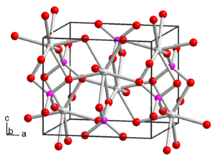Chemistry:Yttrium(III) phosphate

| |
| Names | |
|---|---|
| IUPAC name
Yttrium phosphate
| |
| Identifiers | |
3D model (JSmol)
|
|
| ChemSpider | |
| EC Number |
|
PubChem CID
|
|
| |
| |
| Properties | |
| YPO4 | |
| Molar mass | 183.877 |
Except where otherwise noted, data are given for materials in their standard state (at 25 °C [77 °F], 100 kPa). | |
| Infobox references | |

Yttrium phosphate, YPO4, is the phosphate salt of yttrium.[1] It occurs in nature as minerals xenotime[2] and weinschenkite.[3]
Preparation
Yttrium phosphate can be obtained by reacting yttrium chloride and sodium phosphate, or by reacting yttrium nitrate and diammonium hydrogen phosphate in solution:[2]
Yttrium phosphate can also be prepared by the reaction of yttrium(III) oxide and diammonium hydrogen phosphate:[4]
Yttrium chloride and phosphoric acid are mixed at 35~40°C, and then ammonia solution is added dropwise to react:[5]
Properties
Yttrium phosphate belongs to the tetragonal crystal system, and the unit cell parameters are a=0.68832 nm, c=0.60208 nm. It can exist as a monohydrate, dihydrate or the anhydrous form. The dihydrate belongs to the monoclinic crystal system, the space group is B 2/b, and the unit cell parameters are a=0.648 nm, b=1.512 nm, c=0.628 nm, β=129.4°, Z=4.[6]
Yttrium phosphate reacts with concentrated alkali to form yttrium hydroxide.[7]
Uses
Yttrium phosphate is used as a catalyst and is a potential containment material for nuclear waste.[2] Ce3+-doped yttrium phosphate shows luminescence in the UV range and can be used for tanning lamps.[8][9] Double-doped materials such as Ce3+-Tb3+ have also been reported.
References
- ↑ Greenwood, Norman N.; Earnshaw, Alan (1997). Chemistry of the Elements (2nd ed.). Butterworth-Heinemann. p. 526. ISBN 978-0-08-037941-8.
- ↑ 2.0 2.1 2.2 Macintyre, Jane Elizabeth; Daniel, F. M.; Stirling, V. M. (1992). Dictionary of inorganic compounds. London Glasgow New York [etc.]: Chapman & Hall. ISBN 978-0-412-30120-9.
- ↑ minsocam.org: WEINSCHENKITE, YTTRIUM PHOSPHATE DIHYDRATE, retrieved 16 May 2014
- ↑ Georg Brauer: Handbuch der Präparativen Anorganischen Chemie. 3., umgearb. Auflage. Band I. Enke, Stuttgart 1975, ISBN 3-432-02328-6, S. 1114.
- ↑ Руководство по неорганическому синтезу: В 6-ти т.. 4. М.: Мир. 1985.
- ↑ Справочник химика. 1 (2-е изд., испр ed.). М.-Л.: Химия. 1966.
- ↑ Yi, Xianwu; Huang, Chunhui (2011). Kang. Wu ji hua xue cong shu (Di san ci yin shua ed.). Bei jing: Ke xue chu ban she. ISBN 978-7-03-030574-9.
- ↑ Alsfasser, Ralf (2007) (in de). Moderne anorganische Chemie: mit CD-ROM. de Gruyter. ISBN 978-3-11-019060-1. https://books.google.com/books?id=HwY4be5bH_sC&pg=PA318.
- ↑ "铈激活磷酸钇发光材料_爱学术". https://www.ixueshu.com/document/66a4b6e64603bc3697507f7cd6ff1242318947a18e7f9386.html.
 |

